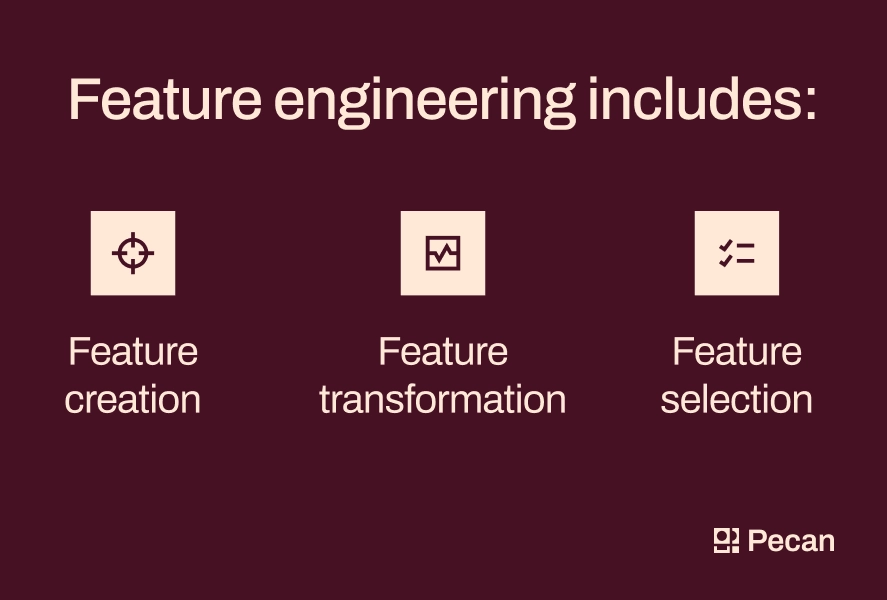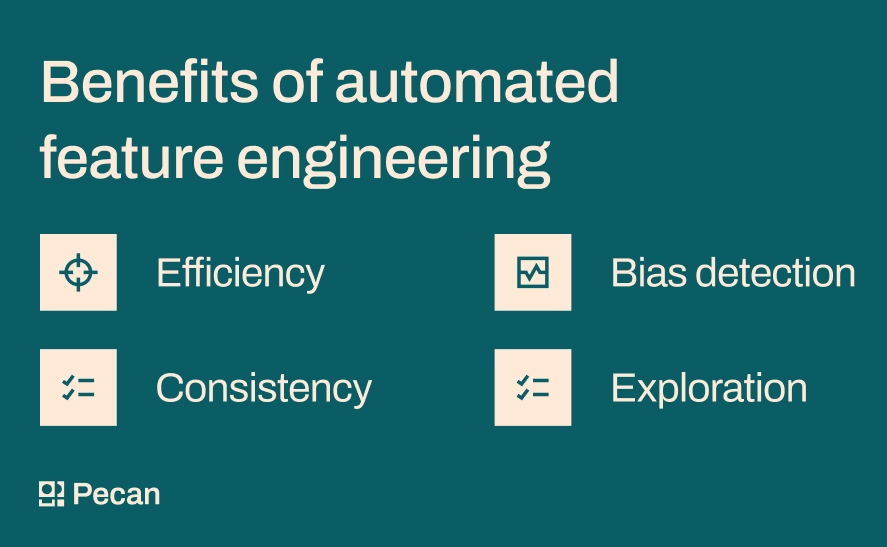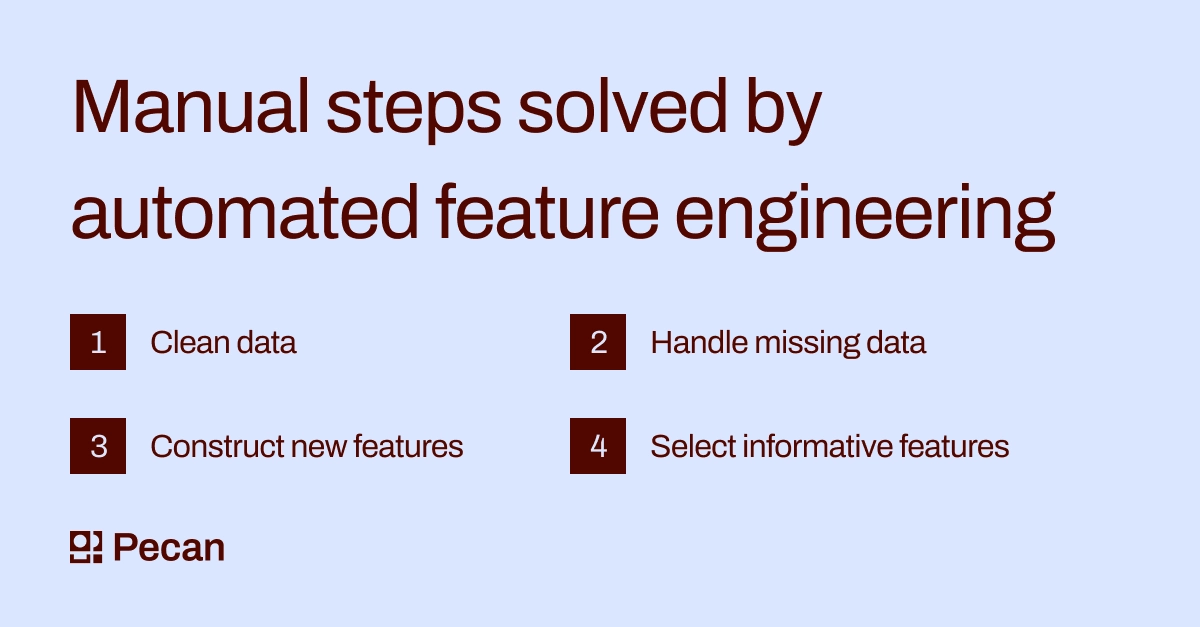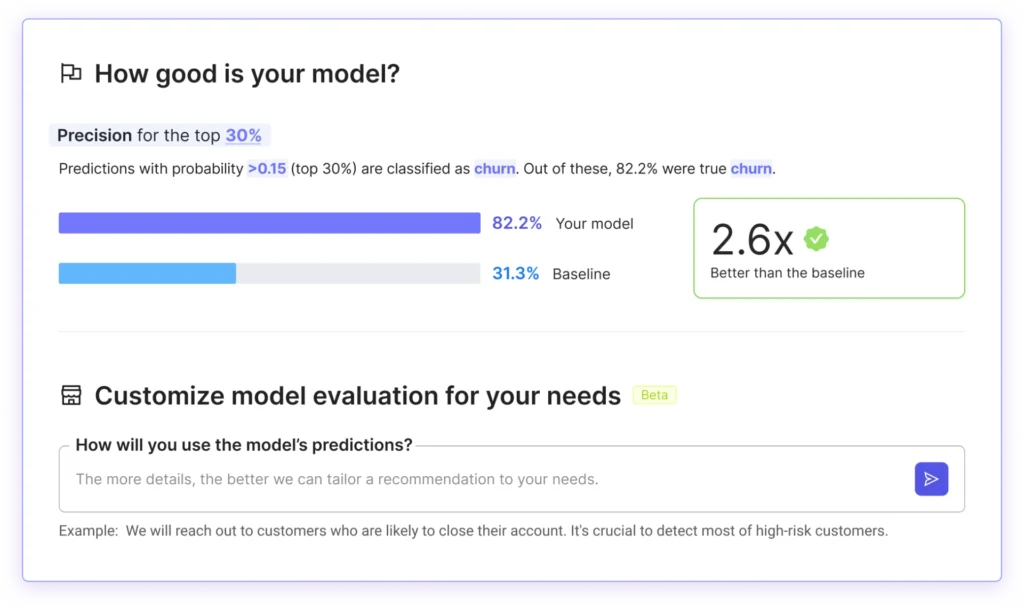In a nutshell:
- Feature engineering is a crucial step in machine learning, but it can be time-consuming, inconsistent, and error-prone when done manually.
- Automated feature engineering tools can streamline the process by cleaning up data, constructing features, and surfacing relevant variables specific to your data and business problem.
- The benefits of automated feature engineering include efficiency, bias detection, consistency, and deeper exploration of data.
- Pecan offers automated feature engineering capabilities, allowing for rapid model iteration and refinement without the need for extensive coding skills.
- By integrating automated feature engineering, organizations can bypass the complexities of manual feature engineering and quickly leverage sophisticated, efficient machine-learning models.
Your data team is getting excited about how machine learning can help them, but they’re facing some obstacles. Traditional data science is time-consuming and requires expertise — which you and your team may need some upskilling to obtain. You may have also seen some bias creep into your analytics due to human error, and you’re getting inconsistent model outputs.
Many of these errors and challenges start during one of the first and most essential stages of the data science process — feature engineering, where you must choose and build the right variables for your model.
In this blog, we explore the basics of feature engineering and introduce how Pecan’s automated feature engineering can help you uncover the most impactful variables from your data — some that may not be immediately obvious, even to seasoned data scientists.
The basics of feature engineering
What is a feature?
A feature is essentially an input variable for your machine-learning model. Features can vary drastically, from numeric values (like salary) to categories (such as colors or days of the week) and more. Your model's outputs will depend on which features you use to build your model.
One often-used analogy for feature engineering is cooking. If your machine learning model output is a delicious soup, features are the ingredients that make it up. Other foods in your pantry can be features that don’t make it into the soup. That doesn’t mean they aren’t tasty ingredients; it just means they may not be the right flavors for what you’re making.
What is feature engineering?
Feature engineering is the strategic selection of features for your machine learning model. It includes creating, transforming, and selecting features.
During feature creation, you’ll generate new features from your raw data. Feature transformation involves changing how features are represented, improving their quality and making sure they’re suitable for your machine-learning model. Finally, feature selection is where you’ll choose the most relevant features or variables for your machine-learning model to optimize results and accuracy.
-

- The components of feature engineering
Here’s an example: Consider you're building a model to enhance subscription renewals for your mobile app. You might identify “age,” “location,” and “purchase data” as crucial features. However, choosing whether or not to add a feature you calculate to represent "in-app time" could dramatically change the results of your model.
The full process of effective feature engineering ensures your model is well-equipped to drive business value.
What are the challenges of manual feature engineering?
Feature engineering is a critical step in machine learning, but it comes with its own set of challenges.
It’s time-intensive
Manual feature engineering takes time. A lot of it. Picking which features to use in your model and making sure they’re ready for the model-building process involves deep analysis and expertise from your data team. When you’re under tight deadlines or your team lacks sufficient resources, the time required for thorough feature engineering can really bog down your entire data science project.
It lacks consistency
Consistency is key, and without it, your model's performance can vary dramatically. If your team doesn’t consistently apply the same criteria when selecting features, or if these criteria shift over time without a solid reason, your model's reliability could suffer. Maintaining a uniform approach throughout the feature selection process is essential for dependable results. Inconsistent feature selection or features built on insufficient training data can also lead to overfitting and underfitting, causing models to underperform.
It’s error-prone
If you select the wrong features or overlook important ones, your model won’t perform as well as it could or should. Missing a critical feature might mean missing out on valuable insights, while including irrelevant features could introduce noise, reducing the precision and usefulness of your models.
Take out the complexity with automated feature engineering
Feature engineering is a high-stakes part of the machine learning process. It requires expertise, time, and precision — and if mistakes are made, your entire model will be less than optimal.
Thankfully, there’s a solution that relieves many of the concerns of manual feature engineering.
How does automated feature engineering work?
There are two types of automated feature engineering tools. Some are built directly into the machine learning platform you’re using, others are standalone solutions. But both types work similarly. First, you’ll feed your raw data into the automated feature engineering tool, and it will:
- Clean up your data (removing duplicates, handling missing values, etc.)
- Prepare new features from the data you’ve provided through aggregation, interaction, and other feature engineering methods
- Select the most informative features for your specific model
Automated feature engineering can even help you think of entirely new features based on the important relationships highlighted in your data.
-

- Why automated feature engineering can surpass manual efforts
The benefits of automated feature engineering
We highlighted some of the concerns related to manual feature engineering: time, consistency, and errors. Automated feature engineering resolves those concerns and more. Here’s a look at some of the benefits of automated feature engineering.
Efficiency
Automated feature engineering is the key to scaling your machine learning initiatives. With automated feature engineering, you can quickly create, transform, and select the most important features, giving your team the capacity to handle more data science projects. This scalability also ensures that as your data grows and your needs evolve, your machine-learning processes can grow with them.
Bias detection
Every person working on the machine learning model will bring their own experience, expertise, and, unfortunately, preconceived notions to the table. Automated feature engineering helps remove bias — whether from human error or conscious and unconscious bias — by automatically surfacing important and complex relationships in the data that may not be readily visible at first glance.
Consistency
When multiple data professionals are involved in feature engineering, or even when a single professional works across different models at various times, achieving consistency in feature engineering is a difficult task. Even with excellent documentation, maintaining consistency can be difficult and time-consuming, not to mention if your data has outliers or missing values.
With automated feature engineering, you can quickly pinpoint errors, outliers, and missing values while using AI to surface the most important relationships in your data. This standardized approach to selecting and preparing features means you won’t have to worry about inconsistency, suboptimal results, or overfitting and underfitting.
Exploration
A critical component of the data science process is the ability to experiment and rapidly iterate machine learning models. Automated feature engineering, like in Pecan’s platform, helps data professionals quickly build and iterate SQL-based machine learning models in minutes, giving data workers of varying skill levels the freedom to rapidly scale and experiment.
-

- The manual steps in feature engineering eliminated by an automated approach
Understand your data on a deeper level with Pecan’s automated feature engineering
Because of its long list of advantages, automated feature engineering is built directly into Pecan’s Predictive GenAI platform.
Our low-code analytics platform is constructed to make the entire data science process as easy as possible.
- Pecan connects to multiple data sources and has built-in data cleansing, blending, and preparation
- Pecan can automatically detect and surface the most relevant features, eliminating the tedious and error-prone aspects of manual feature selection
- Predictive GenAI features quickly and easily help you define your business problem, choose a model, and generate SQL-based models
Our platform is incredibly fast at spinning up and generating new models, allowing data scientists and analysts to rapidly iterate and refine their models. Analysts particularly benefit from automated feature engineering as it provides them a hands-on opportunity to upskill into more advanced data science capabilities, enhancing their understanding of predictive modeling without the steep learning curve typically associated with coding in R and Python.
With Pecan, transparency is our top priority. You can view how each feature is utilized within the model and understand its impact on the model’s predictions, ensuring that every step of the process secures your data and empowers your team to make informed business decisions.
Ready to start building machine-learning models?
By integrating automated feature engineering, Pecan allows your organization to leapfrog the traditional complexities of manual feature engineering and dive straight into leveraging a sophisticated, efficient model.
Discover more ways you can use our automated feature engineering by signing up for a free trial or scheduling a demo with our team.



